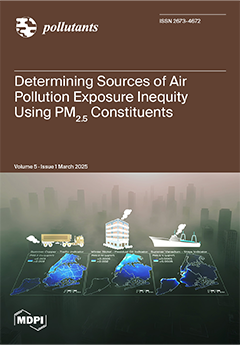Differences in exposures and resources to manage personal health contribute to persistent inequities in air pollution burden despite vast air quality improvements over the past 2–3 decades in the United States. These factors are, partly, linked to historic racist practices, such as redlining,
[...] Read more.
Differences in exposures and resources to manage personal health contribute to persistent inequities in air pollution burden despite vast air quality improvements over the past 2–3 decades in the United States. These factors are, partly, linked to historic racist practices, such as redlining, a discriminatory housing policy that was practiced legally between 1935 and 1968. Using 100 m × 100 m resolution land-use regression predicted surfaces of PM
2.5 constituents (black carbon, nickel, vanadium, and copper) as pollution source indicators, we fit Bayesian generalized linear mixed-effects models to examine differences in source exposures over two study periods, 2008–2015 and 2016–2019, comparing (1) redlined to not redlined and (2) high-asthma to low-asthma neighborhoods. We examine redlining as an indicator of historical, and structural racism and asthma rates as an indicator of present-day community burden. Redlined areas saw near elimination of disparities in exposure to residual oil boilers and marine residual oil but persistent disparities in traffic. High-asthma neighborhoods continue to have disproportionately high exposures to both residual oil boilers and traffic, with no discernable disparities related to marine residual oil emissions. Overall exposure disparities are small, with PM
2.5 disparities by both asthma morbidity and redlining amounting to less than 1 µg/m
3 and NO
2 disparities by asthma and redlining amounting to less than 2 ppb in the post-2016 period. For context, 2019 NYC average PM
2.5 and NO
2 were 8.5 µg/m
3 and 20 ppb, respectively. Our findings suggest that local pollution policy should focus on reducing traffic and building boiler emissions in high-asthma neighborhoods to reduce exacerbations.
Full article





